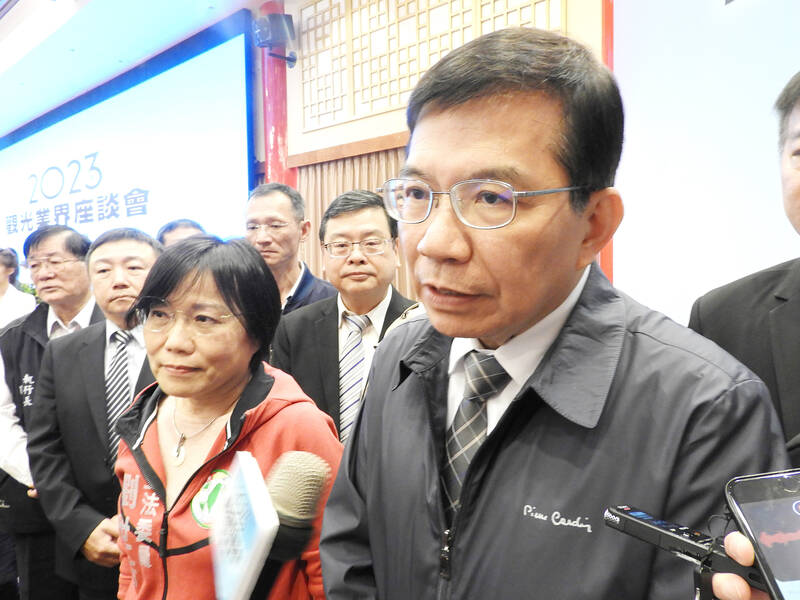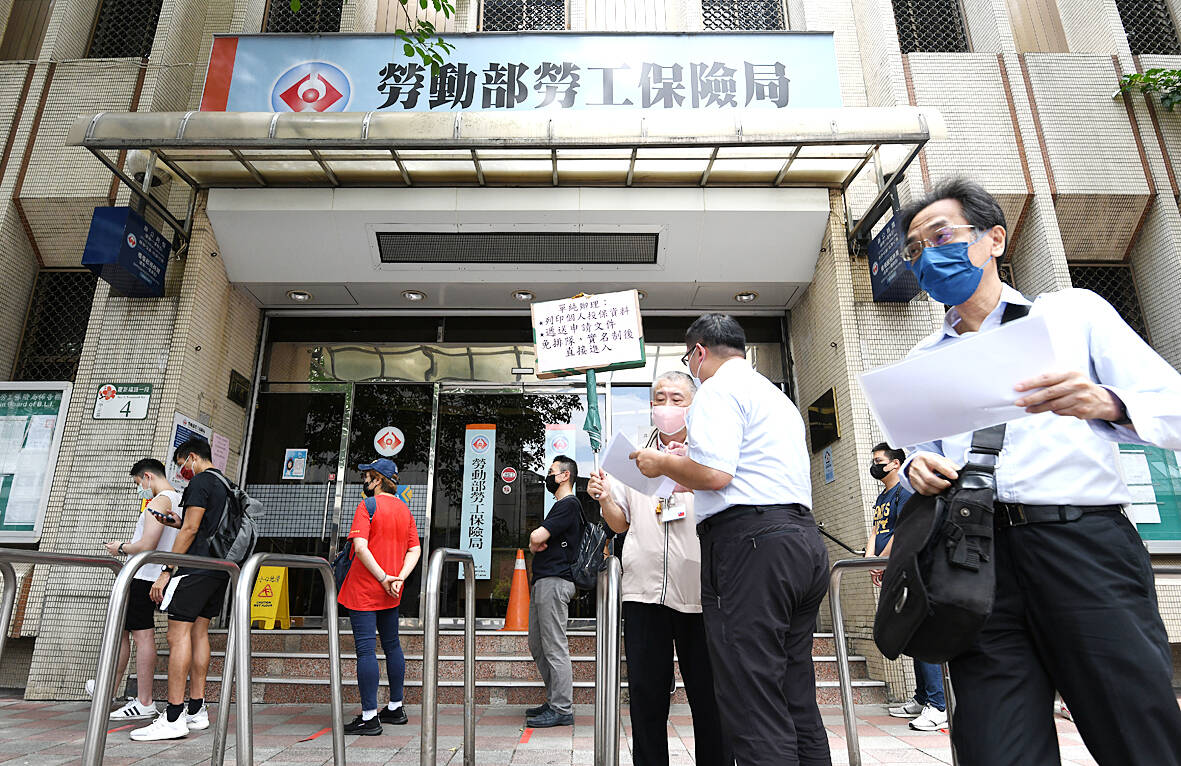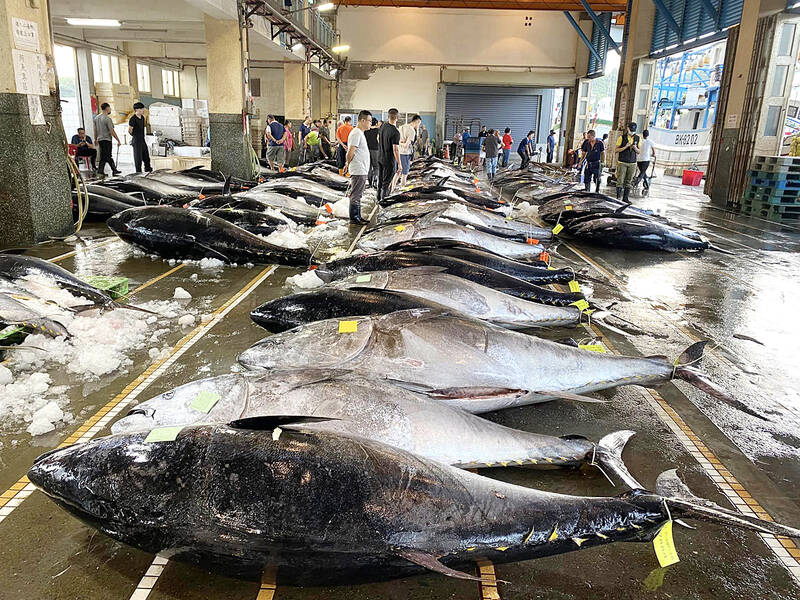The local media reported last week that Taiwan’s tuna fishermen had a record haul of the embattled creatures: nearly 3,900 bluefin tuna. TaiwanPlus reported that local fishermen attributed the record catch to the tuna fishing pact between Taiwan and Japan inked in 2013, which permitted fishermen to work in areas that both countries claim.
Large catches seem like a good thing, but Taiwan’s fishing fleet is a creation of government subsidy programs. A glance at food security numbers shows seafood as one area in which Taiwan is “self-sufficient.” However, this self-sufficiency is an illusion possible only because it continues to gain access to distant waters to fish.
In fact, the massive harvest is largely exported to Europe, Japan and the US. Fishing, it seems, is just another export industry. Taiwan imports the raw materials from afar, then processes them for re-export, buoyed by an array of subsidies.

Photo: Liu Hsin-te, Taipei Times
Fuel subsidies for industrial fishing for exports are an important component of Taiwan’s fisheries subsidy program (there used to be a well developed local black market in subsidized fishing fuel), but subsidies also go for local production of fish such as tilapia and grouper for export.
Even ornamental fish for export are subsidized. In 2011 the government broke ground on an ornamental fish research center in Pingtung County whose goal was to make Taiwan a major player in the ornamental fish market.
Of course, subsidies prop up industries all over Taiwan. They are Taiwan’s reflexive response to every economic and social issue. Tourism? Shower cash on tourists entering Taiwan. Not enough labor? Open the cash taps!

Photo: Ke Yu-hao, Taipei Times
KEEPING WAGES LOW
The ruling Democratic Progressive Party (DPP) last week said it was implementing a one-year subsidy program for services industry workers, ostensibly to help the industry, which is crippled by labor shortages. And what a coincidence, it’s an election year.
According to government statistics released in May, 70 percent of young people make between NT$27,000 and NT$29,000 a month. The government blamed the lack of training in what it termed key industries, but if the youth remain untrained, that is the fault of the government’s educational system that slots so many of them into training for low paying jobs in an education system that, thanks to subsidies, has too many universities.

Photo: Liao Chen-hui, Taipei Times
As many noted, the service industry subsidy program did nothing to address the underlying structural problems of the low wages. Taiwan’s planners largely grew up under the developmentalist state, when wages were kept low to grow the economy by export. The idea that raising wages and upgrading workers could help drive better living standards and a stronger economy receives lip service from planners, but remains a distant dream.
It should also be noted that the government handed out subsidies last year for marketing in the wake of the pandemic’s destructive effects on the restaurant industry. Several observers noted that the DPP took a beating in the election in part because many small and informal businesses died off during the pandemic, and voted against the ruling party for not bailing them out. Perhaps the DPP is attempting to address this problem by spreading the subsidy around better.
CRIPPLING SHORTAGES

Photo courtesy of Tsai Yuan-lung
After the 2008 economic crisis, the central bank gave the nation years of cheap money. The government — despite the Chinese Nationalist Party’s (KMT) claims to be the rational party that was good at the economy — did little to push businesses to upgrade and sat serenely back while housing prices skyrocketed, especially in the north, and labor conditions steadily worsened.
The result was a distorted investment environment that saw the share of investment in machines and equipment in Taiwan fall nearly a third between 2002 and 2018. Service businesses, though dominant in the economy, remain small, with low profits and profit margins, and weak ability to engage in investments in capital upgrades and research and development.
Alas, the nation’s crippling shortage of mid-level technical workers, editorialized in the Taipei Times last week (“Labor shortage hindering growth,” June 26, 2023), cannot be addressed by flows of cash. It can only be changed by restarting vocational programs and allowing mid-level workers to immigrate to Taiwan. Ironically, that same week the government announced the subsidy plan for service wages, it released the news that the unemployment rate had reached a 23-year low of 3.46 percent. Local media reported that though Taiwan’s exports remain moribund, service industry demand for labor was driving an ongoing fall in the unemployment rate.
How great is this demand? My wife and some of her Filipino friends went lychee picking on a farm in northern Taiwan last week, and the owner offered them all informal farm work on the spot. Helpful friends constantly bring up places looking for workers to her, then are shocked to learn that the government stupidly bans spouses of ARC holders from working for five years.
The ease with which migrant workers can find illegal work, especially in agriculture, is another indicator that the service sector faces the double whammy of a shrinking labor pool coupled with low salaries, undesirable jobs, and long hours. Migrant workers, essentially a corporate subsidy in human form, running off to find illegal work is the labor version of the black market in gasoline that arose from fisheries subsidies.
LABOR INSURANCE
Taiwan has some of the longest work hours on earth, so naturally the government also announced last week, to add insult to irony, that shorter work hours were just too difficult to arrange.
Another problem for labor has been looming for many years: the labor insurance program. Pensions affect 10 million workers and 600,000 employers. Currently, the problem of pension reform is being solved in the usual way: in May, Deputy Minister of Labor Lee Chun-yi (李俊俋) said that (what else?) continued government subsidies are the only way to keep the program financially stable.
Even the extension of conscription from four months to one year is a subsidy program: the government has decided to throw warm bodies at the problem of defense, rather than spend the money and effort to implement regular reserve training and an active civil defense program.
The news last week said the government was considering offering permanent residency to some Filipino workers. When will that be allowed?
When the government can plausibly explain to itself that they too are a subsidy, designed, like almost all Taiwan government subsidies, to prevent wrenching system change.
Notes from Central Taiwan is a column written by long-term resident Michael Turton, who provides incisive commentary informed by three decades of living in and writing about his adoptive country. The views expressed here are his own.

Nov. 11 to Nov. 17 People may call Taipei a “living hell for pedestrians,” but back in the 1960s and 1970s, citizens were even discouraged from crossing major roads on foot. And there weren’t crosswalks or pedestrian signals at busy intersections. A 1978 editorial in the China Times (中國時報) reflected the government’s car-centric attitude: “Pedestrians too often risk their lives to compete with vehicles over road use instead of using an overpass. If they get hit by a car, who can they blame?” Taipei’s car traffic was growing exponentially during the 1960s, and along with it the frequency of accidents. The policy

What first caught my eye when I entered the 921 Earthquake Museum was a yellow band running at an angle across the floor toward a pile of exposed soil. This marks the line where, in the early morning hours of Sept. 21, 1999, a massive magnitude 7.3 earthquake raised the earth over two meters along one side of the Chelungpu Fault (車籠埔斷層). The museum’s first gallery, named after this fault, takes visitors on a journey along its length, from the spot right in front of them, where the uplift is visible in the exposed soil, all the way to the farthest

While Americans face the upcoming second Donald Trump presidency with bright optimism/existential dread in Taiwan there are also varying opinions on what the impact will be here. Regardless of what one thinks of Trump personally and his first administration, US-Taiwan relations blossomed. Relative to the previous Obama administration, arms sales rocketed from US$14 billion during Obama’s eight years to US$18 billion in four years under Trump. High-profile visits by administration officials, bipartisan Congressional delegations, more and higher-level government-to-government direct contacts were all increased under Trump, setting the stage and example for the Biden administration to follow. However, Trump administration secretary

The room glows vibrant pink, the floor flooded with hundreds of tiny pink marbles. As I approach the two chairs and a plush baroque sofa of matching fuchsia, what at first appears to be a scene of domestic bliss reveals itself to be anything but as gnarled metal nails and sharp spikes protrude from the cushions. An eerie cutout of a woman recoils into the armrest. This mixed-media installation captures generations of female anguish in Yun Suknam’s native South Korea, reflecting her observations and lived experience of the subjugated and serviceable housewife. The marbles are the mother’s sweat and tears,